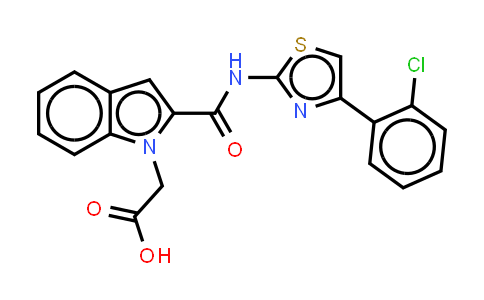| Chemical Name |
Lintitript |
| CAS Number |
136381-85-6 |
| MDL Number |
MFCD00868618 |
| Molecular Formula |
C20H14ClN3O3S |
| Molecular Weight |
411.86 |
| Synonyms |
SR 27897 |
Introduction of 136381-85-6 :
Lintitript (SR 27897) is a highly potent, selective, orally active, competitive and non-peptide cholecystokinin (CCK1) receptor antagonist with an EC50 of 6 nM and a Ki of 0.2 nM. Lintitript displays > 33-fold selectivity more selective for CCK1 than CCK2 receptors (EC50 value of 200 nM). Lintitript increases plasma concentration of leptin and food intake as well as plasma concentration of insulin[1][2][3]. IC50 & Target: EC50: 6 nM (cholecystokinin (CCK1) receptor)[2]; Ki: 0.2 nM (cholecystokinin (CCK1) receptor)[1] In Vitro: In vitro, Lintitript (SR 27897) is a competitive antagonist of cholecystokinin (CCK)-stimulated amylase release in isolated rat pancreatic acini (pA2 = 7.50) and of CCK-induced guinea pig gall bladder contractions (pA2 = 9.57)[1].
Lintitript produces concentration dependent inhibition of [125I]CCK binding to CCK1 receptor sites in the rat pancreas (IC50 value of 0.58 nM) and also to CCK 2 sites in the guinea pig cortex (IC2 value of 479 nM). Lintitript inhibits [125I]gastrin binding to gastrin receptors. Lintitript (0.5 nM) increases the dissociation constant of CCK for the CCK A receptor (Kd = 1.8 to 7.2 nM) without modifying the maximum number of receptors (Bmax = 1800 to 1770 fmol/mg)[1]. In Vivo: Lintitript (SR 27897; 1 mg/kg, i.v.) completely reverses the CCK-induced amylase secretion. Lintitript also inhibits CCK-induced gastric and gallbladder emptying in mice (ED50s = 3 and 72 μg/kg, respectively). Lintitript is also very active (ED50 = 27 μg/kg p.o.) in the gall bladder emptying protocol with egg yolk as an inducer of endogenous CCK release[1].
| Purity |
NLT 98% |
| Storage |
at 20ºC 2 years |
*The above information is for reference only.
